Abstract
In order to shorten the curing time of the cement-treated aggregate base, provide a stable paving base for an asphalt mixture, and finally, achieve rapid traffic reopening during the maintenance of the pavement (milling and resurfacing of the base layer), sulphoaluminate cement (SAC) was used to prepare cement-treated aggregate with high early strength. As a result, the SAC was first optimized by adding several cement admixtures (i.e., polycarboxylic water reducer, borax, lithium carbonate, and calcium formate) based on hydration kinetics, setting time, compressive strength, and morphology tests. Then, the optimized SAC was used to prepare the sulphoaluminate cement-treated aggregate (SACTA). The test results show that the addition of compound retarder and compound early strength agent in SAC could delay the hydration, reduce microcracks, and ensure required setting time and high early strength. Compared with ordinary Portland cement-treated aggregates (OPCTAs) with the same cement content, the 1 d unconfined compressive strength and indirect tension strength of SACTAs increased by 87.7–184.6% and 133.8–263.6% respectively. The SACTA had smaller total drying shrinkage strain and better anti-scouring performance than OPCTA when using the same cement content. Besides, the 1 d interfacial bonding strength between SACTA and OPCTA was 0.18 MPa, which was higher than the indirect tension strength of OPCTA. The findings in this study indicate that the prepared SACTA could be used for rapid traffic opening during road maintenance.
1. Introduction
Cement treated-aggregate (CTA) has become the most widely used material for the base layer of asphalt pavement in China due to its good water stability and excellent load diffusion capacity [1,2,3]. The combining influence of traffic load, water, and temperature predisposes the CTA base to a range of distresses, including fatigue damage, water-induced damage, and shrinkage cracking [4,5,6,7]. When the CTA base is suffering from considerable damage, structural maintenance measures such as milling and resurfacing are typically implemented [8,9]. To ensure adequate load-bearing capacity, traditional CTA base, which typically uses #42.5 Portland cement as the binder, must be cured for more than 7 days before surface layer paving [10]. With increasing traffic volumes, the long curing time of the base can often lead to traffic jams and cause numerous inconveniences to daily life, especially in road sections with heavy traffic, during milling and resurfacing of the base layer. To address these challenges, enhancing the early strength of CTA may be an effective approach to shorten the curing time of the base and expedite surface layer paving, thereby enabling prompt traffic resumption.
Currently, there are two primary methods to enhance the early strength of CTA, including improving the interlocking effect between aggregates (e.g., modifying the CTA compaction method [11,12], optimizing the aggregate gradation of CTA [13,14,15]), enhancing the bonding effect between the cement paste and aggregate (e.g., increasing the curing temperature of CTA [16], using cement early strength agents [17,18,19], and increasing cement content [20,21]). Of them, Deng et al. [22,23] investigated the influences of a vertical-vibration–compaction method, cement dosage, aggregate type, and aggregate gradation on the unconfined compressive and resilient modulus of CTA. They concluded that the strength of CTA on day 3 can be enhanced by increasing cement dosage, and the strength of CTA prepared with limestone and skeleton-dense gradation is the highest. However, solely increasing the early strength through improvements in the interlocking effect between aggregates may not meet the requirements for rapid surface layer paving (shorter than 1 day) and traffic reopening. Wang et al. [24] compared the effects of different early strength agents on CTA strength and concluded that the compound early strength agent (chloride salt and organic amine) is more significant than that of a single early strength agent in enhancing the compressive strength. It should be noted that the utilization of cement early strength agents and an increase in cement content often lead to issues such as excessive shrinkage and strength loss in the later stages of CTA.
Sulphoaluminate cement (SAC) is characterized by a short setting time, high early strength, small expansion, and shrinkage compensation, and has been widely used in many rapid repair projects [25,26,27]. However, the extremely short initial setting time (less than 30 min) of SAC cannot meet the time requirement of CTA base construction. The retarders based on hydroxylic organic compounds such as tartaric and gluconic acids [28,29], and borax [30] are normally employed to extend the setting time of SAC. However, a single retarder has a limited impact on delaying SAC hydration. Additionally, retarders usually reduce the early strength of cement.
In this paper, to address the issues caused by the long-time curing of traditional CTA, a novel CTA is prepared by using SAC as the binder. However, although SAC has high early strength, the very short setting time makes it unsuitable for preparing CTA. As a result, different cement admixtures are introduced to optimize the performance of SAC. The hydration kinetics, setting time, compressive strength, and morphology of SAC with different cement admixtures are tested and compared. The optimized SAC is then used to prepare sulphoaluminate cement-treated aggregate (SACTA). After that, the influence of optimized SAC content on the mechanical performance, drying shrinkage, and anti-scouring performance of SACTA are investigated by performing a series of experiments. The above performance characteristics of the SACTA are also compared with those of traditional ordinary Portland cement-treated aggregate (OPCTA).
2. Materials and Methods
2.1. Cement and Cement Admixtures
The materials used in this study were rapid-hardening #42.5 SAC and #42.5 ordinary Portland cement. Based on our previous study [31], the cement admixtures included in this study were a polycarboxylic water reducer (PCE), borax (B), lithium carbonate (LC), and calcium formate (CF). PCE and B are retarders; LC and CF are early strength agents. To improve the water retention of SAC, 5% silica fume (SF) was used to replace SAC.
The SAC, OPC, and SF were characterized by X-ray fluorescence, and the chemical compositions are shown in Table 1.

Table 1.
SAC and silica fume chemical composition.
2.2. Measurements on SAC Paste
In order to investigate the effects of a single cement admixture and compound cement admixtures on the hydration kinetics, early compressive strength, and setting time of SAC, the SAC pastes were prepared with a constant water–cement ratio of 0.31. The mix ratios are shown in Table 2.

Table 2.
Formulations of the SAC pastes.
The heat evolution of the SAC pastes was monitored at 20 °C for 1 d using a TAM Air micro-calorimeter (Thermometric AB, Stockholm, Sweden). The compressive strength and setting time of the SAC pastes and OPC paste were tested according to the Chinese specification JTG 3420-2020 [32]. The fragments of SAC paste after the compressive strength test were washed with isopropyl alcohol three times to terminate hydration, and the morphology of the SAC pastes was observed by scanning electron microscope (SEM, FEI Quanta 200F, Hillsboro, OR, USA).
2.3. Preparation and Test Methods of CTA
2.3.1. Aggregates and Mixture Proportion of CTA
The aggregates of CTA are limestone from Changsha, Hunan Province. To investigate the effects of the optimized SAC content on the mechanical, drying, shrinkage and anti-scouring performance of SACTA, five SACTAs were prepared with different optimized SAC contents, i.e., 3.0%, 3.5%, 4.0%, 4.5%, and 5.0% by weight of aggregate. The OPC content was set as 4.0% by weight of aggregate to prepare ordinary Portland cement-treated aggregate (OPCTA) as the control group. The aggregate gradations of SACTA and OPCTA are presented in Figure 1a. The prepared cylindrical specimens are shown in Figure 1b.
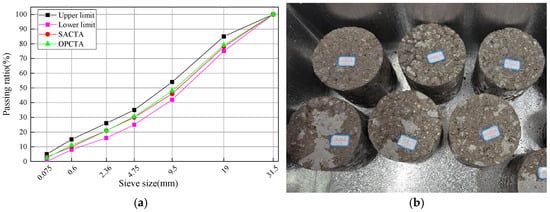
Figure 1.
(a) The aggregate gradation of SACTA and OPCTA; (b) the cylindrical specimens.
2.3.2. Compaction Test
Prior to the preparation of the specimens, the modified Proctor compaction method was applied to determine the optimum moisture content and maximum dry density of SACTAs and OPCTA according to the Chinese specification JTG 3441-2024 [10]. The specimens were compacted in three layers, with 98 impacts per layer. Five different water contents (3.5%, 4%, 4.5%, 5%, 5.5%) were used.
2.3.3. Mechanical Performance Test
According to the results of the optimum moisture content in the compaction test, the cylindrical specimens (ϕ150 × h150 mm) of SACTAs and OPCTA were prepared by the static pressure method for the strength, compression modulus of resilience, and scouring tests. Beam specimens (100 mm × 100 mm × 400 mm) of SACTAs and OPCTA were prepared for the drying shrinkage test. Six specimens were prepared for each type of test condition. The specimens were sealed in a plastic bag and cured in a curing room (temperature of 20 ± 2 °C and relative humidity over 95%). On the last day of the curing time, the specimens were taken out and immersed in water for 24 h. The unconfined compressive strength and indirect tension strength were tested according to the Chinese specification JTG 3441-2024 [10].
The compression modulus of resilience was tested by the top-surface measuring method [10]. The maximum load applied was taken as 50% of the unconfined compressive strength of the specimen. The load was divided into five distinct levels.
The bonding strength between fresh SACTA base and existing OPCTA base is an important index to evaluate maintenance effect. A thin card was inserted into the middle of the mold and the specimens were named S-PCTAs, as shown in Figure 2. The specimens of S-PCTAs were cured for 1 d, 3 d, 7 d, and 28 d. The splitting test was used to test the interfacial bonding strength of S-PCTAs, which was then compared with the indirect tension strength of OPCTA.
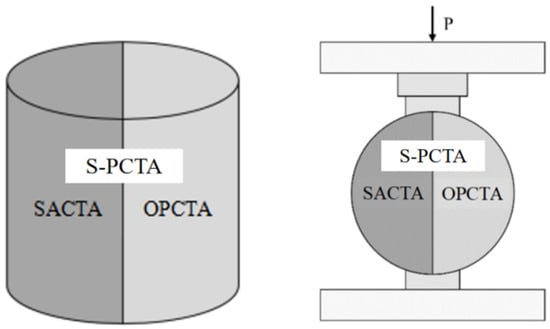
Figure 2.
Schematic diagram of interfacial bonding strength test.
2.3.4. Scouring Test
The scouring test, which was used to evaluate the anti-scouring performance of CTA under the combined effect of load and water, was carried out using the vibrating table of the VeBe Consistometer. The specimens of SACTA and OPCTA that were cured for 7 d were put into the scouring bucket, and then water was added. The water surface was 5 mm above the top surface of the specimen. The scouring frequency was 50 Hz, and the additional load on the top surface of the specimen was 2750 g. Due to the specimens being in the process of molding, curing, and transportation, it was inevitable that some damage was produced on the surface of the specimen. The weak surface of the specimen would be scoured down quickly, so the pre-scouring test had to be carried out first.
3. Results and Discussion
3.1. Performance Optimization of SAC and Mechanistic Investigations
3.1.1. Hydration Kinetics of SAC Paste
The hydration kinetics of the SAC pastes are shown in Figure 3. The heat output during the process of adding water into the SAC, stirring, and molding in the instrument was not recorded. The heat flow of L1 only showed a peak due to the rapid hydration of the SAC. Compared with L2 and L3, the second hydration peak of L4 was dramatically delayed, indicating that the compound retarder (PCE + B) had a stronger retardation effect than a single retarder on the hydration of the SAC.
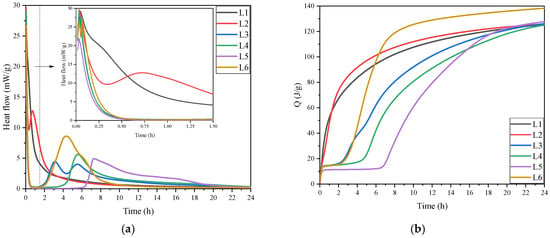
Figure 3.
The heat evolution of SAC pastes; (a) heat flow (b) cumulative heat.
It is interesting to note that the addition of LC to L4 did not accelerate the hydration as it did in other studies [33,34,35]. This may be because the large amount of Ca3B2O3 produced due to the high dose of B in L5 wrapped around the surfaces of the SAC particles, which prevented the dissolution of SAC particles. A small amount of LiOH produced due to the low dose of LC could not dissolve the protective layer of Ca3B2O3 on the surfaces of SAC particles, and the CaCO3 produced by LC was also wrapped around on the surface, further preventing the dissolution of SAC particles.
It can be seen from Figure 3b that the heat release time of L6 was obviously later than that of L1, but its cumulative heat was greater than that of L1, indicating that the addition of compound retarder and compound early strength agent in L1 could not only delay the hydration of SAC but also increase its hydration degree.
3.1.2. Setting Time and Compressive Strength of SAC Paste
The objective of this paper is to optimize the performances of SAC with long setting time and high early strength, and thus to prepare the CTA with ultra-high early strength. A fast hydration rate of cement typically correlates with shorter setting time and increased early strength. Therefore, based on the hydration kinetics results, only L1, L4, and L6 were tested for early compressive strength and setting time, as shown in Table 3.

Table 3.
The setting time and compressive strength of SAC pastes.
The initial and final setting time of L4 and L6 were significantly longer than those of L1, which was consistent with the results of the hydration kinetics. Although the addition of compound early strength agent shortened the setting time of L4, the 90 min of initial setting time could meet the time requirement of CTA base construction. The 12 h and 1 d strength of L4 were significantly lower than those of L1, decreasing by 19.6% and 14.4%, respectively, while the 12 h and 1 d strength of L6 decreased by only 6.7% and 3.2%, respectively. Compound early strength agent (LC + CF) could reduce the negative effect of compound retarder (PCE + B) on the early strength of SAC.
3.1.3. SEM of SAC Paste
The morphology of SAC pastes after curing for 1 d are shown in Figure 4. By comparing the SEM images (×1000) of L1, L4, and L6, it can be seen that the addition of the compound retarder led to larger and more microcracks in the SAC paste. The compound early strength agent could reduce and narrow the microcracks of the SAC paste and make its microstructure denser. This is the reason that the hydration of L6 was significantly slower than that of L1, but the 1 d strength only decreased by 3.2%. Many rodlike and fibrous AFt and globular AH3 gels of the SAC hydration product can be observed in Figure 4b.
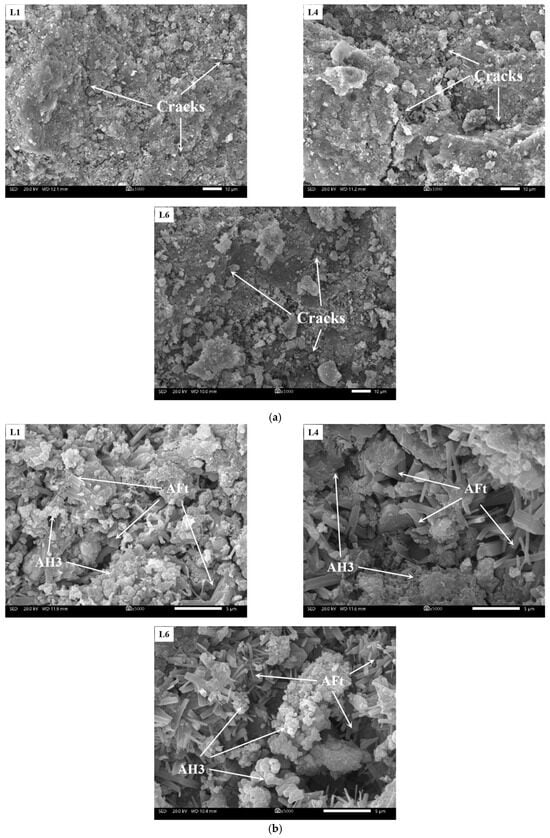
Figure 4.
The SEM of SAC pastes (a) ×1000 and (b) ×5000.
According to the above results, it is evident that the retardation effect of a single retarder on cement hydration was insignificant. While the compound retarder effectively extended the setting time of SAC, it simultaneously resulted in a decrease in early strength. Therefore, to ensure that SAC has a long initial setting time and high early strength for the preparation of CTA, the compound retarder and compound early strength agent are optimum cement admixtures.
3.2. Optimum Moisture Content and Maximum Dry Density of CTA
According to the results of the early strength and setting time tests, the SAC paste (L6) was used to prepare the specimens of SACTA. The quadratic polynomial fit method is used to fit the compaction curves of SACTAs and 4% OPCTA, as shown in Figure 5a. The optimum moisture content and maximum dry density were determined by the peak of the compaction curve, as shown in Figure 5b. The optimum moisture contents of SACTAs varied little with increasing optimized SAC content, but were lower than 4% OPCTA, due to the fact that the optimized SAC hydrated faster than OPC and consumed more water. Although some researchers argued that a portion of the compaction energy was required to break hydrated chemical bonding products of cement, resulting in a reduction in density as cement content increased [36]. As the optimized SAC content increased, more cement particles filled the voids between aggregates, which led to a decrease in the void ratio. And, the mass of SACTA increased with higher optimized SAC content, resulting in an increase in the maximum dry density of SACTA.
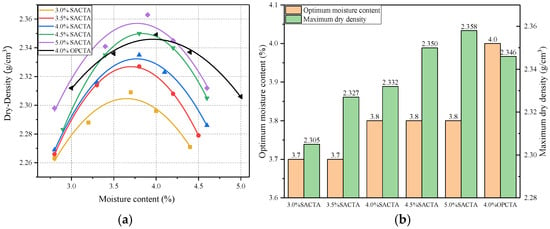
Figure 5.
Compaction test: (a) compaction curves of OPCTA and SACTAs and (b) optimum moisture content and maximum dry density of OPCTA and SACTAs.
3.3. Mechanical Performances of CTA
3.3.1. Unconfined Compressive Strength and Indirect Tension Strength
The results of the unconfined compressive strength and indirect tension strength tests of SACTAs and 4% OPCTA are shown in Figure 6a and Figure 6b, respectively. The error bars represent standard deviation.
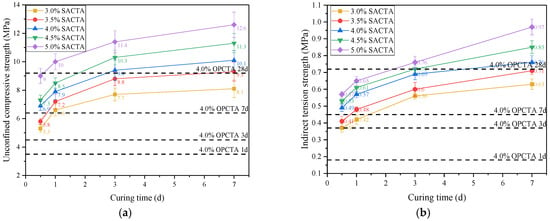
Figure 6.
Strength test results of SACTAs and 4% OPCTA: (a) unconfined compressive strength and (b) indirect tension strength.
It could be concluded that the unconfined compressive strength and indirect tension strength of SACTAs at the same curing time were higher than those of 4% OPCTA, and they both increased with the increase in optimized SAC content and curing time. This can be attributed to the fact that the hydration of optimized SAC was faster than that of OPC, which was particularly evident during the early curing time, thus effectively promoting a rapid enhancement in the early strength of SACTAs. For example, the 12 h unconfined compressive strength of SACTAs were 63.0–71.3% of their 7 d unconfined compressive strength. However, the 1 d unconfined compressive strength of 4% OPCTA was only 38.2% of its 7 d unconfined compressive strength, as shown in Figure 6a.
According to the Chinese Specification JTG F20-2015 [8], the traditional OPCTA base layer uses the 7 d unconfined compressive strength as the main indicator for construction quality control. The minimum requirement for the 7 d unconfined compressive strength standard value of the traditional OPCTA base layer on an expressway is 5 MPa. Taking 7 d unconfined compressive strength of 4% OPCTA as the minimum requirement for surface layer paving in this paper, the 12 h unconfined compressive strength of SACTAs with optimized SAC content higher than 4% and 1 d unconfined compressive strength of SACTAs with optimized SAC content higher than 3% could meet the requirement. This means that optimized SAC could be used to prepare SACTA with ultra-high early strength, which can meet the requirement for the surface layer paving in a short time, thus enabling rapid traffic opening.
Compared with 4% OPCTA, the 1 d unconfined compressive strength and indirect tension strength of SACTAs increased by 87.7–184.6% and 133.8–263.6%, respectively. The increased ratio of 1 d indirect tension strength was much higher than that of 1 d unconfined compressive strength. This result is because the unconfined compressive strength was provided by both the bonding effect between the cement paste and aggregate, and the interlocking effect between aggregates, while the indirect tension strength was mainly provided by the bonding effect at the early curing time.
3.3.2. Effect of Delay Time on Unconfined Compressive Strength
The delay time is the time difference between the mixing and the molding of the CTA base, which was used to characterize the construction potential of CTA. Due to the construction processes of mixing, transporting, paving, and compacting the CTA base, the time delay generally has an adverse effect on the strength of CTA. Although the reduction in strength can be overcome by remixing the material with a grader (i.e., breaking the hydrated chemical bonds) and adding water, the effect of time delay on strength must be considered, as the reduction in strength will still be significant as some of the cement has already hydrated.
The specimens of mixed SACTAs were kept for 20 min, 40 min, 60 min, and 80 min before molding. The 1 d unconfined compressive strength of SACTAs molded after different delay times are shown in Figure 7.
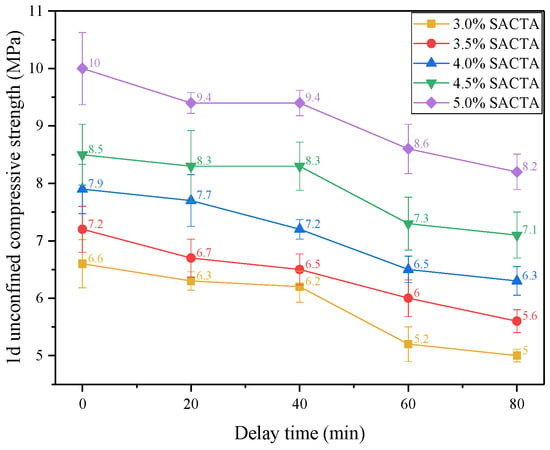
Figure 7.
Effect of delay time on 1 d unconfined compressive strength.
Overall, delay time had a negative effect on the unconfined compressive strength of SACTA. Taking the 4% SACTA for example, the 1 d unconfined compressive strength decreased by 3.8%, 8.9%, 19.0%, and 20.3% after delaying for 20 min, 40 min, 60 min, and 80 min. The reason is that optimized SAC began to hydrate when water was added, and molding after different delay times would produce disturbances to the combination of hydration products of cement and aggregate, resulting in a strength reduction of the CTA. Therefore, during the construction of SACTA, the content of optimized SAC should be adjusted according to the delay time. Although the delay time would reduce the unconfined compressive strength of SACTA, the 1 d unconfined compressive strength of 3% SACTA after an 80 min delay time could still meet the minimum requirement for surface layer paving of the expressway (5 MPa) [8].
3.3.3. Compression Modulus of Resilience
The compression modulus of resilience of CTA is an essential parameter for asphalt pavement design and has a great influence on the fatigue life of asphalt pavement [37]. The results of the compression modulus of resilience of SACTAs and 4% OPCTA are shown in Figure 8. Obviously, the compression modulus of resilience of SACTAs increased with the increase in optimized SAC content and were higher than that of 4% OPCTA at the same curing time. Compared with 3.0% SACTA, the 1 d compression modulus of resilience of 4% OPCTA was reduced by 32.0%, while those of SACTAs with 3.5–5.0% optimized SAC content increased by 23.8%, 38.4%, 55.3%, and 60.9%, respectively.
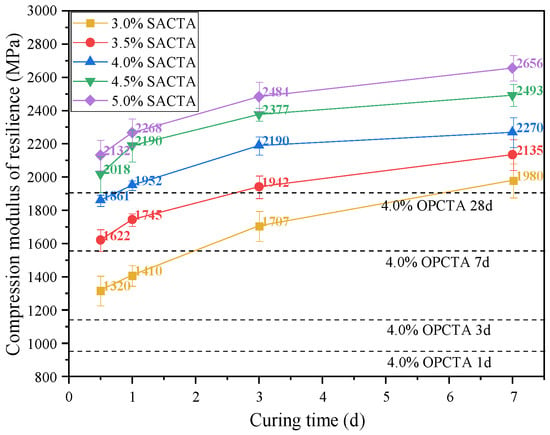
Figure 8.
Compression modulus of resilience of SACTAs.
3.3.4. Interfacial Bonding Strength
Since the hydration products of cement bind the aggregates at the interface of SACTA and OPCTA together to form the interfacial bonding strength, more hydration products would lead to greater interfacial bonding strength. The interfacial bonding strength of the S-PCTAs are shown in Table 4, and the 1 d, 3 d, 7 d, and 28 d indirect tension strength of 4% OPCTA were 0.18 MPa, 0.37 MPa, 0.46 MPa, and 0.72 MPa, respectively.

Table 4.
The interfacial bonding strength of the S-PCTAs.
The hydration of optimized SAC is faster than that of OPC, so the 1 d indirect tension strength of 4% OPCTA is lower than the 1 d interfacial bonding strength of S-PCTAs. As time increased, the hydration of optimized SAC gradually completed while the hydration of OPC continued; 4% OPCTA had more hydration products than 3.0% S-PCTA and 3.5% S-PCTA. In addition, the high cement of 4% OPCTA contributed to the above result. The 28 d indirect tension strength of 4% OPCTA was higher than the 28 d interfacial bonding strength of 3.0% S-PCTA and 3.5% S-PCTA.
3.3.5. Drying Shrinkage Strain
The drying shrinkage is one of the main reasons for the cracking of CTA, which seriously affects the durability and safety of pavement [38]. As a result, the dry shrinkage strain was used as an evaluation index to evaluate the cracking resistance of CTA. The results of the drying shrinkage strain of the SACTAs and 4% OPCTA are shown in Figure 9.
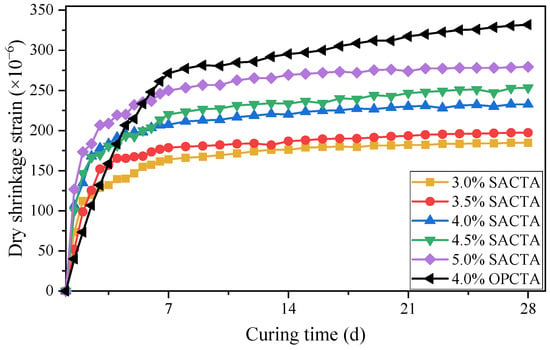
Figure 9.
Drying shrinkage strain of OPCTA and SACTAs.
The drying shrinkage strain of SACTAs increased with the increase of optimized SAC content and increased at a very fast speed in the first 3 days. It can also be found that the drying shrinkage strain of SACTAs was higher than that of 4% OPCTA at the early curing time. However, beginning from the 7th day, the drying shrinkage of 4% OPCTA began to be higher than those of SACTAs, which means SACTA had better cracking resistance.
Chemical shrinkage of cement is the main cause of drying shrinkage of CTA in the early curing time and the decrease in water inside the CTA due to the change of humidity. Temperature in the external environment is the main cause of drying shrinkage of CTA at the later curing time. Since hydration of optimized SAC mainly occurred in the first 3 days, and the hydration speed and degree were both higher than those of OPC, chemical shrinkage of SAC was greater than that of OPC, resulting in greater drying shrinkage of the SACTA at the early curing time. During hydration, 1 g of C3S consumes 0.42 g of water, and 1 g of C4A3 consumes 0.78 g of water. When the same mass of the optimized SAC and OPC hydrated completely, the optimized SAC consumed more water [39]. Therefore, the moisture content and the relative internal humidity of SACTA were much lower than those in the OPCTA, resulting in greater drying shrinkage of the OPCTA at the later curing time.
3.4. Scouring Test of CTA
The pre-scouring test was carried out for 5 min, and the scouring amount was recorded every minute. The results are shown in Figure 10. In the first 2 min of scouring, the scouring amounts of SACTAs and 4% OPCTA were large, because the weak surface of the specimens was quickly scoured down at the beginning of vibration. After 3 min, the scouring amount per minute rapidly decreased and gradually stabilized, so the scouring amount of SACTAs and 4% OPCTA were recorded every 5 min after 5 min in the scouring test, for a total of 30 min.
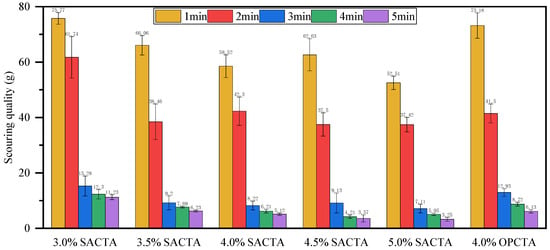
Figure 10.
Pre-scouring test results of OPCTA and SACTAs.
The scouring amount of SACTAs and 4% OPCTA per 5 min is shown in Figure 11. Considering SACTAs and 4% OPCTA had relatively small scouring amounts after 20 min, the scouring test after 20 min was not investigated. At the same scouring time, the higher optimized SAC content led to a smaller scouring amount. Compared with 4% OPCTA, 4% SACTA had a lower scouring amount at the same scouring time, indicating that SACTA had a stronger anti-scouring performance than OPCTA.
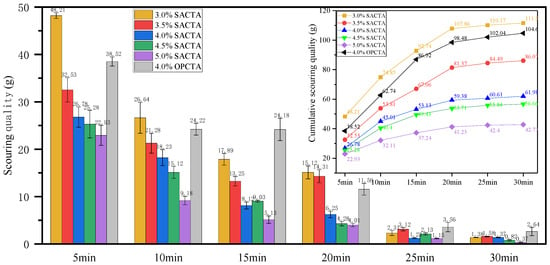
Figure 11.
Scouring test results of OPCTA and SACTAs.
4. Conclusions
OPCTA is inappropriate to use in asphalt pavement where traffic needs to open quickly. In order to solve this issue, a novel CTA named SACTA was prepared. First, different cement admixtures were used to optimize the performance of SAC to extend the setting time and improve the early strength so as to prepare the CTA with high early strength. To study the feasibility of maintaining a CTA base layer with optimized SAC, SACTAs with different optimized SAC contents were prepared, and the performances of SACTAs and 4% OPCTA were tested and compared. Based on the test results, this paper has the following main conclusions:
- (1)
- The compound retarder (PCE + B) dramatically delayed the hydration and setting time and reduced the early strength of SAC. The addition of early strength agent (LC) enhanced the retarding effect of compound retarder on the hydration of SAC. The compound early strength agent (LC + CF) reduced the negative effect of the compound retarder (PCE + B) on the early strength of SAC. The incorporation of compound retarder and compound early strength agent ensured that SAC had enough setting time and high early strength to prepare CTA.
- (2)
- Increasing the optimized SAC content could increase the unconfined compressive strength, indirect tension strength, and compression modulus of resilience of SACTAs, which were higher than those of 4% OPCTA at the same curing time. The 1 d unconfined compressive strength of the SACTAs after 80 min delay time could meet the minimum requirement of surface layer paving of the highway.
- (3)
- The interfacial bonding strength between SACTA and OPCTA was higher than the indirect tension strength of OPCTA, indicating that optimized SAC was a good maintenance material for CTA.
- (4)
- The drying shrinkage strain of SACTA was lower than that of 4% OPCTA, indicating that SACTA had better cracking resistance. The results of the scouring test show that SACTA had better anti-scouring performance than OPCTA.
5. Recommendations
It can be found that the prepared SACTA had high road performances, such as unconfined compressive strength, interfacial bonding strength, and drying shrinkage resistance. However, in many cases where the mixing plant is far away from the field site, the setting time of the optimized SAC should be further prolonged. The initial setting time should be longer than 180 min.
Author Contributions
Conceptualization, D.W.; Methodology, L.K., D.W. and Y.D.; Software, Y.D.; Validation, L.K.; Formal analysis, S.W.; Investigation, J.X.; Resources, H.W. and S.W.; Data curation, L.K. and H.W.; Writing—original draft, L.K. and Y.D.; Visualization, J.X. and S.W.; Supervision, D.W. and H.W.; Project administration, J.X. All authors have read and agreed to the published version of the manuscript.
Funding
This work was supported by the Hunan Provincial Natural Science Foundation (Grant No. 2023JJ60216), the Hunan Provincial Department of Education Scientific Research Outstanding Youth Project (Grant No. 24B1026).
Data Availability Statement
The original contributions presented in this study are included in the article. Further inquiries can be directed to the corresponding authors.
Conflicts of Interest
The authors declare that they have no conflicts of interest.
References
- Huang, T.; Qi, S.; Liu, H.; Yu, H.; Li, S. Shear properties of asphalt mixtures under triaxial compression. Appl. Sci. 2019, 9, 1489. [Google Scholar] [CrossRef]
- Li, J.; Zi, J.; Jiang, T.; Hu, T.; Feng, Z. Impact of the implementation of continuous construction method on pavement cracking performance. Int. J. Pavement Eng. 2016, 17, 201–210. [Google Scholar] [CrossRef]
- Sun, Y.; Li, L. Strength assessment and mechanism analysis of cement stabilized reclaimed lime-fly ash macadam. Constr. Build. Mater. 2018, 166, 118–129. [Google Scholar] [CrossRef]
- Francois, A.; Ali, A.; Mehta, Y. Evaluating the impact of different types of stabilised bases on the overall performance of flexible pavements. Int. J. Pavement Eng. 2019, 20, 938–946. [Google Scholar] [CrossRef]
- He, M.; Ma, S.; Liu, C.; Zhang, J.; Yuan, S. Effect of microcracking on the shrinkage cracking and durability performance of cement-treated macadam material. Int. J. Pavement Eng. 2022, 23, 4909–4922. [Google Scholar] [CrossRef]
- Lv, S.; Xia, C.; You, L.; Wang, X.; Li, J.; Zheng, J. Unified fatigue characteristics model for cement-stabilized macadam under various loading modes. Constr. Build. Mater. 2019, 223, 775–783. [Google Scholar] [CrossRef]
- Lv, S.; Peng, X.; Yuan, J.; Liu, H.; Liu, J. Stress path investigation of fatigue characteristics of cement stabilized macadam. Constr. Build. Mater. 2021, 292, 123446. [Google Scholar] [CrossRef]
- JTG F20-2015; Technical Guidelines for Construction of Highway Roadbases. China Communication Press: Beijing, China, 2015.
- JTG D50-2017; Specifications for Design of Highway Asphalt Pavement. China Communication Press: Beijing, China, 2017.
- JTG 3441-2024; Test Methods of Materials Stabilized with Inorganic Binders for Highway Engineering. China Communications Press: Beijing, China, 2024.
- Li, P.; Wei, D.; Zhang, D.; Xu, S. Study on the properties and mechanisms of a cement-stabilized aggregate mixture with vibration mixing. Front. Mater. 2021, 8, 634336. [Google Scholar] [CrossRef]
- Tian, T.; Jiang, Y.; Zhang, Y.; Deng, C.; Yi, Y.; Fan, J. Strong interlocking skeleton gradation design and performance evaluation of cement-stabilised crushed gravel via vertical vibration test method. Int. J. Pavement Eng. 2023, 24, 2021404. [Google Scholar] [CrossRef]
- Du, Q.; Pan, T.; Lv, J.; Zhou, J.; Ma, Q.; Sun, Q. Mechanical properties of sandstone cement-stabilized macadam. Appl. Sci. 2019, 9, 3460. [Google Scholar] [CrossRef]
- Li, Z.; Chen, Y.; Meng, Q.; Wang, C.; Guan, J.; Zhang, L. Study on Pavement Performance of Cement Stabilized Recycled Brick Aggregate Base with Basalt Fiber. Adv. Mater. Sci. Eng. 2022, 2022, 2347736. [Google Scholar] [CrossRef]
- Ma, Y.; Gu, J.; Li, Y.; Li, Y. The bending fatigue performance of cement-stabilized aggregate reinforced with polypropylene filament fiber. Constr. Build. Mater. 2015, 83, 230–236. [Google Scholar] [CrossRef]
- Adresi, M.; Khishdari, A.; Ahmadi, A.; Rooholamini, H. Influence of high content of reclaimed asphalt on the mechanical properties of cement-treated base under critical environmental conditions. Int. J. Pavement Eng. 2019, 20, 1098–1105. [Google Scholar] [CrossRef]
- Kawashima, S.; Hou, P.; Corr, D.J.; Shah, S.P. Modification of cement-based materials with nanoparticles. Cement Concr. Compos. 2013, 36, 8–15. [Google Scholar] [CrossRef]
- Land, G.; Stephan, D. The effect of synthesis conditions on the efficiency of CSH seeds to accelerate cement hydration. Cement Concr. Compos. 2018, 87, 73–78. [Google Scholar] [CrossRef]
- Mangat, P.S.; Ojedokun, O.O.; Lambert, P. Chloride-initiated corrosion in alkali activated reinforced concrete. Cement Concr. Compos. 2021, 115, 103823. [Google Scholar] [CrossRef]
- Hu, W.; Nie, Q.K.; Huang, B.S.; Su, A.W.; Du, Y.; Shu, X.; He, Q. Mechanical property and microstructure characteristics of geopolymer stabilized aggregate base. Constr. Build. Mater. 2018, 191, 1120–1127. [Google Scholar] [CrossRef]
- Guotang, Z.; Wei, S.; Guotao, Y.; Li, P.; Degou, C.; Jinyang, J. Mechanism of cement on the performance of cement stabilized aggregate for high speed railway roadbed. Constr. Build. Mater. 2017, 144, 347–356. [Google Scholar] [CrossRef]
- Deng, C.; Jiang, Y.; Lin, H.; Ji, X. Mechanical-strength-growth law and predictive model for cement-stabilized macadam. Constr. Build. Mater. 2019, 215, 582–594. [Google Scholar] [CrossRef]
- Deng, C.; Jiang, Y.; Tian, T.; Chen, Z. Resilient modulus and influencing factors of vertical vibration compacted cement-stabilized macadam. Int. J. Pavement Eng. 2021, 22, 1435–1445. [Google Scholar] [CrossRef]
- Wang, L.; Shen, A.; Lyu, Z.; Guo, Y.; He, Z.; Mou, G. Rapid regeneration cement-stabilized macadam: Preparation, mechanical properties, and dry shrinkage performance. Constr. Build. Mater. 2022, 341, 127901. [Google Scholar] [CrossRef]
- Cai, G.; Zhao, J. Application of sulphoaluminate cement to repair deteriorated concrete members in chloride ion rich environment-a basic experimental investigation of durability properties. Ksce. J. Civ. Eng. 2016, 20, 2832–2841. [Google Scholar] [CrossRef]
- Ma, J.; Wang, H.; Yu, Z.; Shi, H.; Wu, Q.; Shen, X. A systematic review on durability of calcium sulphoaluminate cement-based materials in chloride environment. J. Sustain. Cem.-Based Mater. 2023, 12, 687–698. [Google Scholar] [CrossRef]
- Zhao, J.; Cai, G.; Gao, D.; Zhao, S. Influences of freeze–thaw cycle and curing time on chloride ion penetration resistance of Sulphoaluminate cement concrete. Constr. Build. Mater. 2014, 53, 305–311. [Google Scholar] [CrossRef]
- Subramanian, S.; Moon, S.W.; Moon, J.; Ku, T. CSA-treated sand for geotechnical application: Microstructure analysis and rapid strength development. J. Mater. Civil. Eng. 2018, 30, 04018313. [Google Scholar] [CrossRef]
- Zajac, M.; Skocek, J.; Bullerjahn, F.; Haha, M.B. Effect of retarders on the early hydration of calcium-sulpho-aluminate (CSA) type cements. Cement Concr. Res. 2016, 84, 62–75. [Google Scholar] [CrossRef]
- Gelli, R.; Tonelli, M.; Ridi, F.; Martini, F.; Calucci, L.; Borsacchi, S. Effect of borax on the hydration and setting of magnesium phosphate cements. Constr. Build. Mater. 2022, 348, 128686. [Google Scholar] [CrossRef]
- Du, Y.; Wang, S.; Xue, Z.; Ma, C. Performance regulation and mechanism of sulphoaluminate cement for cement treated aggregate. J. Railw. Sci. Eng. 2023, 20, 1–10. [Google Scholar]
- JTG 3420-2020; Testing Methods of Cement and Concrete for Highway Engineering. China Communication Press: Beijing, China, 2020.
- Coumes, C.; Dhoury, M.; Champenois, J.B.; Mercier, C.; Damidot, D. Combined effects of lithium and borate ions on the hydration of calcium sulfoaluminate cement. Cement Concr. Res. 2017, 97, 50–60. [Google Scholar] [CrossRef]
- Li, B.; Ling, X.; Liu, X.; Li, Q.; Chen, W. Hydration of Portland cements in solutions containing high concentration of borate ions: Effects of LiOH. Cement Concr. Compos. 2019, 102, 94–104. [Google Scholar] [CrossRef]
- Wolf, J.J.; Jansen, D.; Goetz-Neunhoeffer, F.; Neubauer, J. Impact of varying Li2CO3 additions on the hydration of ternary CSA-OPC-anhydrite mixes. Cement Concr. Res. 2020, 131, 106015. [Google Scholar] [CrossRef]
- Sounthararajah, A.; Nguyen, N.; Bui, H.; Jitsangiam, P.; Leung, G.; Kodikara, J. Effect of cement on the engineering properties of pavement materials. Mater. Sci. Forum. 2016, 866, 31–36. [Google Scholar] [CrossRef]
- Pasetto, M.; Nicola, B. Recycling of waste aggregate in cement bound mixtures for road pavement bases and sub-bases. Constr. Build. Mater. 2016, 108, 112–118. [Google Scholar] [CrossRef]
- Zheng, Y.; Zhang, P.; Cai, Y.; Jin, Z.; Moshtagh, E. Cracking resistance and mechanical properties of basalt fibers reinforced cement-stabilized macadam. Compos. Part B-Eng. 2019, 165, 312–334. [Google Scholar] [CrossRef]
- Ke, G.; Zhang, J.; Liu, Y.; Xie, S. Pore characteristics of calcium sulfoaluminate cement paste with impact of supplementary cementitious materials and water to binder ratio. Powder Technol. 2021, 387, 146–155. [Google Scholar] [CrossRef]
Disclaimer/Publisher’s Note: The statements, opinions and data contained in all publications are solely those of the individual author(s) and contributor(s) and not of MDPI and/or the editor(s). MDPI and/or the editor(s) disclaim responsibility for any injury to people or property resulting from any ideas, methods, instructions or products referred to in the content. |
© 2025 by the authors. Licensee MDPI, Basel, Switzerland. This article is an open access article distributed under the terms and conditions of the Creative Commons Attribution (CC BY) license (https://creativecommons.org/licenses/by/4.0/).